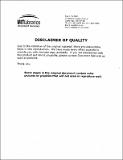| dc.contributor.advisor | Paula T. Hammond. | en_US |
| dc.contributor.author | Johnson, Mark Alan, 1975- | en_US |
| dc.contributor.other | Massachusetts Institute of Technology. Dept. of Chemical Engineering. | en_US |
| dc.date.accessioned | 2005-08-23T20:58:52Z | |
| dc.date.available | 2005-08-23T20:58:52Z | |
| dc.date.copyright | 2002 | en_US |
| dc.date.issued | 2002 | en_US |
| dc.identifier.uri | http://hdl.handle.net/1721.1/8533 | |
| dc.description | Thesis (Ph.D.)--Massachusetts Institute of Technology, Dept. of Chemical Engineering, 2002. | en_US |
| dc.description | Includes bibliographical references. | en_US |
| dc.description.abstract | Linear-dendritic diblock copolymers combine the properties of dendritic macromolecules with the morphology of block copolymers, making it possible to create nanostructured materials which self assemble in the bulk state to form ordered thin films, and in solution to form highly functional micellar systems. The linear-dendritic system described here consists of 2000 molecular weight linear polyethylene oxide (PEO) with a polyamidoamine (PAMAM) dendron covalently bonded to one chain end. Specular neutron reflectivity has been used to investigate the structure of monolayers formed at an air-water interface. The dendritic end groups were functionalized with deuterated stearic acid to make the dendritic block hydrophobic, resulting in a macroamphiphile. Results indicate that stable monolayers are formed with PEO resting on the subphase and stearate groups extending into the air. Surface concentration and dendrimer generation were both found to impact monolayer formation. | en_US |
| dc.description.abstract | (cont.) EM, SAXS and DSC have been used to characterize bulk morphology in PEO-PAMAM. A segregated melt state with elongated globular PAMAM domains is observed for generations 2.0 through 4.0 at temperatures above the PEO melting point. Below the PEO melting point the morphology is disrupted by PEO crystallinity with the extent of disruption depending on generation. Stearate functionalized PEO-PAMAM diblocks also exhibit a segregated melt state at elevated temperatures. Crystallization of the stearate groups creates hard confinement with PEO crystallization inside lamellar domains observed for all generations at room temperature. A free energy model is presented for microphase segregation of linear-dendritic diblock copolymers with an amorphous linear block. This model combines expressions for the stretching free energy of linear chains and interfacial energy with a static model for dendritic branching in order to predict a phase diagram for microphase segregation. Results indicate that surface tension and repulsion in the dendrimer block each have strong impact on phase boundaries. Finally, metallic gold nanoclusters were formed in aqueous solution in conjunction with PEO-PAMAM. Particle formation involved the reduction of HAuC14 with excess NaBH4. Particles were formed both above and below the critical micelle concentration (CMC) for PEO-PAMAM. TEM images indicate that particle sizes ranged from 50 to 100 A with smaller, more uniform particles formed at higher PAMAM generations. | en_US |
| dc.description.statementofresponsibility | by Mark Alan Johnson. | en_US |
| dc.format.extent | 202 leaves | en_US |
| dc.format.extent | 13875934 bytes | |
| dc.format.extent | 13875688 bytes | |
| dc.format.mimetype | application/pdf | |
| dc.format.mimetype | application/pdf | |
| dc.language.iso | eng | en_US |
| dc.publisher | Massachusetts Institute of Technology | en_US |
| dc.rights | M.I.T. theses are protected by copyright. They may be viewed from this source for any purpose, but reproduction or distribution in any format is prohibited without written permission. See provided URL for inquiries about permission. | en_US |
| dc.rights.uri | http://dspace.mit.edu/handle/1721.1/7582 | |
| dc.subject | Chemical Engineering. | en_US |
| dc.title | Self-assembly of linear-dendritic diblock copolymers | en_US |
| dc.type | Thesis | en_US |
| dc.description.degree | Ph.D. | en_US |
| dc.contributor.department | Massachusetts Institute of Technology. Department of Chemical Engineering | |
| dc.identifier.oclc | 50880801 | en_US |
